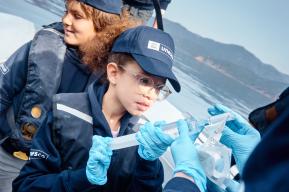出版物
紧急状态


全球变暖、酸化、污染和过度捕捞正在威胁海洋生态系统。这种颓势始于工业时代初期,目前正在加速恶化,甚至已经危及地球的存亡。为此,联合国发布了《海洋科学促进可持续发展10年(2021—2030年)》,旨在推动研究并加强国际科学合作,鼓励人们深入了解复杂浩瀚的海洋,找到可持续性更强的海洋资源开发方法。然而,留给我们的时间寥寥无几,已有66%的海洋环境受到人类活动的严重影响。
阿涅丝·巴尔东(Agnès Bardon)
联合国教科文组织
海洋环境的健康状况不容乐观,其中最令人触目惊心的症状或许是塑料泡沫,即使是远离海岸数英里的海面上也漂浮着这些东西,但这只是冰山一角。各项研究数次清楚无误地表明,占地球表面积71%的海洋正在变暖,海洋资源日益枯竭,海洋酸化日趋加重。
今天,我们已不再纠结这些现象是否会导致更严重的灾害,而是开始关注这些灾害将以怎样的速度蔓延。此事关系重大,涉及到直接依赖海洋谋生的约30亿人的生存问题;从更广泛的意义上说,整个星球的未来都已受到威胁。
海洋是地球的肺,我们呼吸的氧气有部分来自海洋。进入工业时代以来,海洋吸收了温室气体排放产生的大部分多余热量,在调节气候方面起到重要作用。
死亡水域扩散
2019年,政府间气候变化专门委员会(气专委)发布了《气候变化中的海洋和冰冻圈特别报告》,其中的数据显示,自1993年以来,海洋的升温速度与此前25年相比翻了一倍有余。
水温越高,溶于水的氧气就越少。在农业污染的推波助澜之下,这一现象导致死亡水域——缺氧和缺少海洋生物的荒芜水域不断扩大。公海的死亡水域面积在50年里扩大了3倍。于是,有行动能力的生物趋于向南北两极迁移。而珊瑚等无法移动的生物,则注定要承受热应力和环境退化的恶果。海洋温度上升,还意味着水蒸气增加、云层流动发生改变以及干旱或暴雨等极端天气事件频发。
自1993年以来,海洋的升温速度翻了一倍有余
温度升高还导致水体发生热膨胀,造成海平面上升,冰川融化更是加剧了海面上升的情况。按照气专委最乐观的设想,到本世纪末,海平面可能上升0.59米。这直接威胁到居住在小岛屿发展中国家(SIDS)的6500万人口和生活在海拔10米以下地区的约6.8亿居民。
海洋吸收了将近三分之一人类排放的二氧化碳,使我们得以继续在地球上呼吸,但代价是改变海水的化学成分。海水的酸性增强,进一步侵蚀了身披碳酸钙外壳的海洋生物,特别是处于食物链最底层的浮游生物。
海洋生态系统为此付出了沉重的代价。根据生物多样性和生态系统服务政府间科学-政策平台(IPBES)2019年发布的报告,已有66%的海洋生态系统受到人类活动的“严重影响”。1870年至今,珊瑚礁的面积消失了一半,红树林等重要生态系统的分布范围已不足原来的四分之一。
未经探索的世界
上述状况现已基本为大众所知,我们还不够了解的是人类活动导致的这些现象对海洋产生的累积影响。水下依然是一个广阔的未知世界,迄今为止,人类仅探索过5%的海洋。这正是发展海洋科学的目标——解读复杂的海洋生态系统及其与大气的相互作用。
海洋科学综合了物理、生物、化学、地质、水文、卫生科学、工程和社会科学等众多学科,对于开展规划、合理管理海洋资源至关重要。这也是联合国通过的《2030年议程》的可持续发展目标(SDG)之一:“保护和可持续利用海洋和海洋资源”(目标14)。
不过,要探索海洋就需要科考船,需要使用卫星图像和水下机器人。开发这些技术,大笔投资必不可少。然而,联合国教科文组织政府间海洋学委员会(IOC)发布的《全球海洋科学报告》(GOSR)指出,各国用于海洋科学方面的平均开支仅占国家研究预算的1.7%(从0.03%到11.8%不等)。
联合国《海洋科学促进可持续发展10年(2021—2030年)》旨在提醒人们认识到,必须多方筹措资金,加大对这些学科的投入。该计划的目标还包括促进海洋研究方面的国际合作,确定有待开发的科学计划,协调研究方案和海洋空间规划,减少与海洋有关的风险,从而改善对海洋资源和沿海地区的管理。
我们不缺少采取行动的手段。养护工作一旦成功展开,就会取得成果。由于国际社会禁止商业捕鲸活动、渔获量减少,长须鲸和灰鲸等濒危物种的种群数量已有所增加。利用科学研究并借助当地的知识,我们完全有可能改变旧习,保护资源、增强海洋环境的复原力。要达成这个目标,可以规范渔业并划定海洋保护区,但前提是必须消除全球变暖这一有害机制。为了海洋以及地球的未来,我们唯有承担一切代价。
养护工作一旦成功展开,就会取得成果
拓展阅读:
《何止鱼与船》,联合国教科文组织《信使》,2009年5月 。
《监测海洋》,联合国教科文组织《信使》,2005年11月。
《海洋告急》,联合国教科文组织《信使》,2004年12月。
订阅联合国教科文组织《信使》,阅读发人深省的时事文章,数字版免费。
在社交网络上关注联合国教科文组织《信使》:微博、微信公众号“联合国教科文信使”、Twitter、Facebook、Instagram。
Agnès Bardon
UNESCO
The plastic foam that floats on the ocean surface, even miles away from the coast, may be the most spectacular symptom, but is just one indicator of the poor health of the marine environment. In study after study, the diagnosis is clear: the ocean – which covers seventy-one per cent of the world’s surface – is becoming warmer, more depleted, and more acidic.
Today, the question is no longer whether these phenomena are causing major upheavals, but rather, at what rate these will occur. The stakes are high, involving the survival of some three billion people who depend directly on the sea for their livelihoods. More broadly, the very future of the planet is at stake.
The ocean acts as the lungs of the earth, producing part of the oxygen we breathe. By absorbing most of the excess heat generated by greenhouse gas emissions since the beginning of the industrial era, it also plays a major role in regulating the climate.
Proliferation of dead zones
Figures from the Special Report on the Ocean and Cryosphere in a Changing Climate, published by the Intergovernmental Panel on Climate Change (IPCC) in 2019, show that the rate at which the ocean is warming has more than doubled since 1993, compared to the previous twenty-five years.
The warmer the water, the less oxygen can dissolve in it. Exacerbated by agricultural pollution, this phenomenon results in a proliferation of dead zones – areas deprived of oxygen and deserted by marine species. On the high seas, these zones have quadrupled in fifty years. As a result, living organisms that can move, tend to migrate towards the poles. Those that do not have this option, like corals, are condemned to suffer the consequences of heat stress and degradation. A warmer ocean also means more water vapour, a change in the cloud cycle, and an intensification of extreme weather events such as droughts or heavy rainfall.
The rate at which the ocean is warming has more than doubled since 1993
Warming also leads to thermal expansion of the water, causing a rise in sea levels, which are also exacerbated by the melting of glaciers. According to the IPCC’s most optimistic scenario, the rise in sea levels could reach 0.59 metres by the end of the century. This poses a direct threat to the 65 million people living in Small Island Developing States (SIDS) and the around 680 million people living in areas that are less than ten metres above sea level.
By absorbing nearly a third of carbon dioxide emissions released by humans, the ocean has allowed the atmosphere to remain breathable – but at the cost of altering the chemical composition of the water. Marine organisms with calcium carbonate shells, especially those that make up plankton – which are at the bottom of the food chain – are further weakened by water that has become more acidic.
Marine ecosystems pay a heavy price for this. Already, sixty-six per cent are “severely affected” by human activities, according to a 2019 report by the Intergovernmental Science-Policy Platform on Biodiversity and Ecosystem Services (IPBES). As of now, half the surface area covered by coral reefs has disappeared since 1870, and crucial ecosystems such as mangrove forests have been reduced to less than twenty-five per cent of their extent.
Conservation efforts, when carried out successfully, bear fruit
An unexplored world
This state of affairs is now relatively well-known. What is less well-known are the cumulative effects of all these phenomena caused by human activities on the state of the ocean. Much remains to be discovered about this underwater world, of which barely five per cent has been explored so far. This is precisely what the ocean sciences are working on – deciphering this complex universe of marine ecosystems and their interactions with the atmosphere.
Bringing together disciplines such as physics, biology, chemistry, geology, hydrography, health sciences, engineering, and the social sciences, ocean sciences are also essential for planning the rational management of marine resources. This is one of the Sustainable Development Goals (SDGs) for the 2030 Agenda adopted by the United Nations: “Conserve and sustainably use the oceans, seas and marine resources” (Goal 14).
But probing the ocean requires research vessels, the use of satellite images, and recourse to underwater robots. All of these technologies require major investments. However, according to the Global Ocean Science Report (GOSR) of UNESCO’s Intergovernmental Oceanographic Commission (IOC), national spending on ocean sciences represents only 1.7 per cent of national research budgets on average, ranging from 0.03 per cent to 11.8 per cent.
The UN Decade of Ocean Science for Sustainable Development (2021-2030) aims to raise awareness of the need to strengthen and diversify sources of funding for these disciplines. It also aims to facilitate international co-operation in the study of the ocean; to identify gaps in scientific programmes; co-ordinate research programmes and marine spatial planning, and reduce marine-related risks to improve the management of ocean resources and coastal zones.
The means to act do exist. Conservation efforts, when carried out successfully, bear fruit. Endangered species, like the fin whale and the grey whale, have seen their populations increase, thanks to international bans on commercial whaling and reduced catches. By using scientific research, and drawing on indigenous knowledge, it is still possible to change our practices to conserve resources and improve the resilience of marine environments. This can be done by regulating fishing and developing marine-protected areas – but only if the harmful mechanism of global warming is halted. It is at this price that a future is possible for the ocean, and therefore, for the planet.











